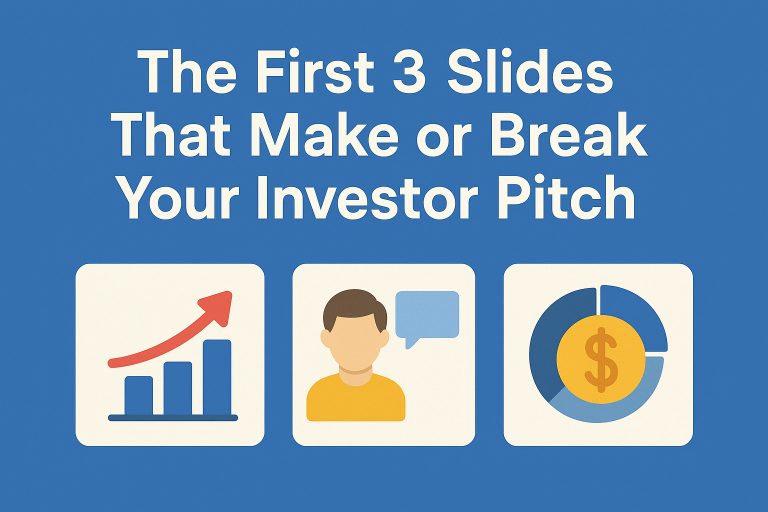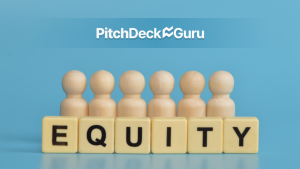Why Your First 3 Slides Decide If Investors Keep Reading (Building the Pitch Deck for GenAi Product in 2025, Step by Step)

✍️ In this blog
I always tell founders: your first three slides decide everything. If you nail them, the audience will smile and lean in. If you miss, they’ll tune out or, honestly, they’ll just zone out. Especially the 1st slide is about grabbing attention and building curiosity. Lets start with our childhood idiom : “First Impression is the Last Impression”
Let Suppose if you have only 72-48 hours to choose the right candidate into 1000s of resumes what would be your best practice to achieve that? defiantly the first block or paragraph of your cover letter decide your intention either you will keep reading or just bin it? Similarly Investors see hundreds of pitch decks. They often decide within the first few minutes whether to keep reading.
Problem Mapping Framework
Component | Description | Example for GenAI Sequence Consistency |
Target Audience | Who suffers the problem? | Animators, video editors, ad agencies, game studios |
Core Problem | What’s the bottleneck? | Manual frame-by-frame adjustments to maintain visual consistency (e.g., color, lighting, style) are time-consuming and error-prone. |
Current Solutions | How is it solved today? | Manual editing (Adobe After Effects), basic AI tools (Runway ML) with limited consistency control. |
Gaps | Why do current solutions fail? | Tools lack contextual understanding of sequences; require repetitive manual input. |
Impact | What’s the cost of the problem? | *”Teams waste 30+ hours/month fixing inconsistencies, delaying projects by 20%.”* |
Slide 1: Problem (Hook)
Content:
Visual:
Why It Matters:
Slide 2: Solution (Your GenAI Product)
How It Works:
Key Features:
Visual:
Workflow diagram: Upload → AI Analysis → Consistent Out
4 Hacks to sell the GenAi Product even in shortest time span
1. The Value Proposition (Vision + Features +Benefits)
Example:
“Our AI-powered SaaS platform automatically enforces the consistency across image sequences and video clips following by the Advanced filters, and Prompt, that Control the Visual Tones Such as unadvised artefacts, breaking visual monotony leads to abrupt transitions. The result? Smooth, Consistent and storytelling at scale—without the post-production hassle.”
What we have Describes above:
- The Vision: The Consistency is our product destiny ( might be Consistency is Core value of our product) (Suggest better)
- The Features: States the solution (Advanced Filters and Prompt focused technology)
- The benefits: (Avoiding the Unadvised Artefacts and breaking Visual Monotony).
2. Explain the Core Technology with Research-Backed Evidence
Key Differentiators
- Consistency: Ensures that every frame should have a Visual sprite, avoiding the visual glitches.
- Google DeepMind (2024) highlighted that even subtle errors (e.g., unnatural hand gestures in images) lead to significant drops in user confidence.
- “And BTW i found lots of Ai images where people had 6-7 fingers in thier hands lolz, funny but true.”
Which Technology we are using:
- Spatiotemporal Attention Mechanisms
- Time and Space-Aware Attention Networks (Ren et al., 2024) enhance motion and layout consistency.
- Noise Initialization from Low-Frequency Bands reduces artefacts while preserving detail[5].
- Temporal Loss Functions (Lai et al., ECCV 2018) optimize for smooth transitions without perceptual degradation[6][9].
- Efficient Neural Training (Lei et al., 2022) avoids costly optical flow computations, enabling real-time processing[7].
Why This Matters
- It adapts dynamically, fixing inconsistencies on the fly.
- It’s Fast and scalable—works for style transfer, colorization, segmentation, and more without retraining[6].
3. Highlight Unique Innovations & Competitive Edge
Key Technical Differentiators
Competitive Comparison:
Feature | Your Solution | Competitor A | Competitor B |
Real-time processing | ✔️ | ❌ (Batch-based) | ✔️ (Limited resolution) |
No optical flow dependency | ✔️ | ❌ | ❌ |
Multi-task consistency | ✔️ (Style, color, segmentation) | ❌ (Single-task) | ❌ (Requires retraining) |
4. Show Measurable Outcomes
- Reduces manual editing time by 40-60% (user-tested).
- Improves visual consistency scores by 35% (perceptual studies).
- Processes 4K video in real-time (benchmarked on NVIDIA A100).
- Saves post-production costs by $X per project.
- Boosts audience retention (consistent visuals = higher engagement).
5. Use Visual Proof to Strengthen Your Case
Recommended Visuals:
- Side-by-side video comparison (with vs. without your AI).
- Architecture diagram (highlighting spatiotemporal attention layers).
- Benchmark graphs (showing speed/quality vs. competitors).
Example:
![Before] → Flickering, inconsistent frames
![After] → Smooth, stable sequence
Sample Pitch Deck Slide: Solution Overview
“How Our AI Solves the Problem”
“Traditional video editing requires manual frame-by-frame fixes to ensure smooth transitions—costing time and consistency. Our AI automates this process using:
🔹 Time and Space-Aware Attention Networks (Ren et al., 2024)
🔹 Temporal Loss Optimization (Lai et al., ECCV 2018)
🔹 Enhancing diversity (Sheng et al., 2022)
The result?
✔ 40% faster editing (user-tested)
✔ 35% higher consistency (perceptual studies)
✔ Seamless 4K processing (no optical flow lag)
For creators, brands, and studios, this means flawless visual storytelling—automated.“
Final Takeaway
We at Pitch Deck Guru produce several growth accelerations features for our clients according to their business needs. Most common tools include Whitepapers, eBooks, Business Reporting, Executive Summaries, and Research Articles.
Email us today!




